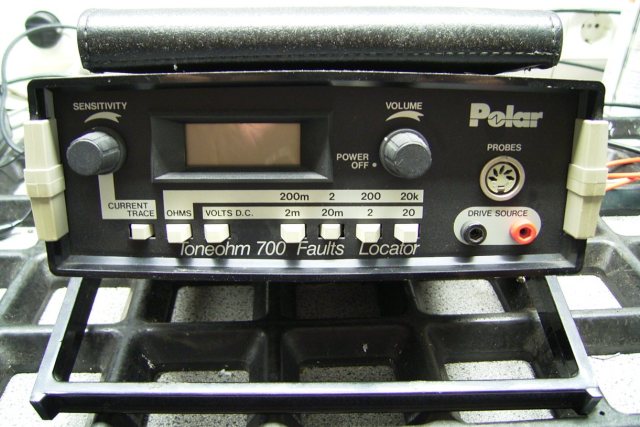Polar 700 Toneohm Faults LocatorDer Polar 700 ist ein Gerät zur Kurzschluss-Fehlersuche an Leiterplatten. Neben einem Ohmmeter und einem DC-Voltmeter Modus kann das Gerät in die "current trace" Betriebsart geschaltet werden. An den "drive source" Ausgängen liefert das Gerät in dieser Betriebsart Rechtecksignale mit 550 mV ss. Zum Empfindlichkeitsabgleich werden die beiden Klemmen des "drive source" Ausganges kurzgeschlossen, und die "current trace" Sonde (current trace probe) an den geschlossenen Kreis herangeführt. Bei einem Abstand von 25mm wird der Empfindlichkeitsregler so eingestellt, dass gerade ein Signalton ertönt. Die Sonde reagiert auf das entstehende Magnetfeld. Danach werden die Klemmen des "current source" Ausganges dann an die Leiterbahnen (Eingänge) angeschlossen, in denen ein Kurzschluss vorliegt. Die Platine selbst muss dabei spannungslos sein. Sind in dem entsprechenden "Spannungszweig" z.B. 20 Kondensatoren an verschiedenen Stellen parallelgeschaltet, von denen einer niederohmig geworden ist, dann wird man beim Anlegen der Probe an dem zu ihm führenden Leiterbahnausleger einen Signalton hören. Der defekte Kondensator kann so ohne mühreliges auslöten aller Kondensatoren, oder dem unschönen unterbrechen von Leiterbahnabschnitten in Minuten lokalisiert werden. Das Gerät lässt sich allerdings nur bis zu einer gewissen "Bestückungsdichte" sinnvoll einsetzen. Ausserdem sollten zu messende, parallele Leiterbahnen einen Mindestabstand von 2 mm haben. Für die Fehlersuche auf einem modernen PC motherboard also eher weniger zu gebrauchen. Andreas ich danke Dir für die Mühe und die Zusendung der Bilder und des Textes von diesem seltenen und bestimmt nützlichen Gerät. The polar 700 is a device for short-circuit error tracing at printed circuit boards. Beside an ohm meter and a DC voltmeter mode can be switched the equipment into "current the trace" mode. To the "drive SOURCE" outputs supplies the equipment in this mode square wave signals with 550 mVpp. For sensitivity alignment the two output clamps "Drive SOURCE" connected to a short circuit, and the "current trace" probe to the closed circle advanced. With a distance from 25mm the sensitivity automatic controller is adjusted in such a way that a straight audio signal sounds. The probe reacts to the developing magnetic field. Afterwards the clamps "current of the SOURCE" of the output are then attached to the layout wires, in which a short-circuit is present. The PCB must be without power thereby. E.g. if 20 parallel connected capacitors in different board locations, it's easy to find the area with low impedance, then an audio signal sounds. The failed capacitor can be found without soldering out of all capacitors or cutting PCB traces. The equipment can be used however only if the board components are not placed too much together or too many of them, meaningfully. In addition, parallel layout wires under test should have a minimum distance of 2 mm. To use for the error tracing on a modern PC motherboard thus rather less. Andreas thank you very much for sending the pictures and the text of this rare and useful instrument.
|

